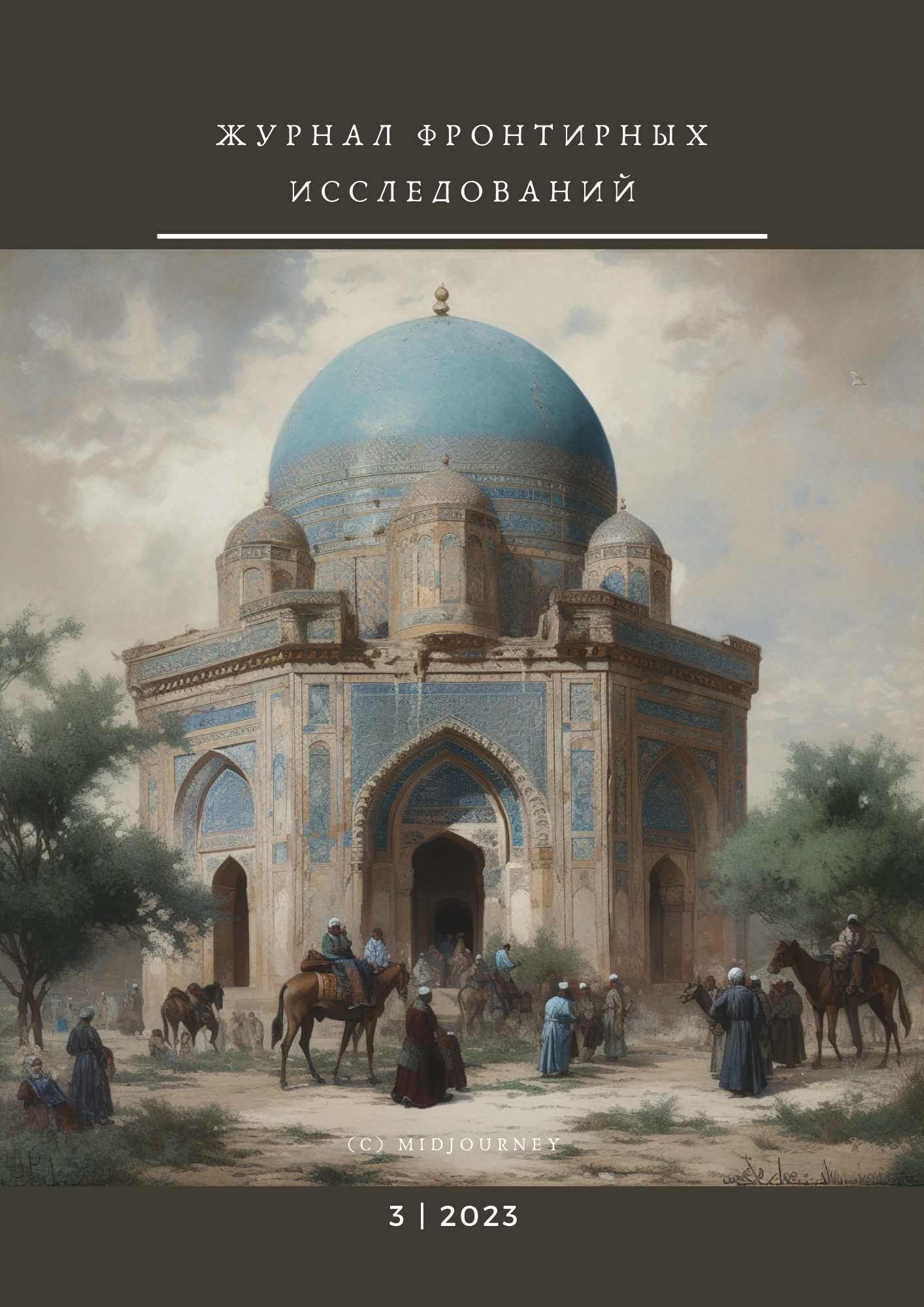Abstract
Hajj represents one of the most significant events in the life of the Muslim community. In the Russian Empire where Islam had become the second largest denomination in terms of the followers by the beginning of the 20th century, the Hajj transitioned from being a purely religious phenomenon to acquiring a certain political significance too. It was through this pilgrimage that Russian citizens professing Islam established relationships with their coreligionists from abroad.
The aim of this study is to trace the degree of participation of Siberian Muslims in this process during the second half of the 19th to early 20th centuries and to assess their ability to perform the Hajj. Relying on archival materials, the authors demonstrate the importance of the process of organizing the Hajj and the participation of Muslims from the Russian Empire. The research revealed that Siberian Muslims were relatively minimally involved in the Hajj for several reasons. Firstly, a portion of the Muslims in Siberia had the status of exiles, which limited their movement both abroad and within the country. Secondly, the remoteness of the territory from the main sanitary checkpoints also discouraged potential pilgrims. In light of these circumstances, a phenomenon known as the “small hajj,” i.e., visiting holy places in Central Asia, became common among Siberian Muslims. The administrative challenges associated with performing the Hajj led many Muslims from various regions of the Russian Empire, including Siberia, to partake in pilgrimages illegally.
This article may be of interest to religious scholars, historians, ethnographers, as well as a broad readership interested in the issues of state-confessional policy in the Russian Empire.
References
Afaunov, T. A. (2008). The Regional Component of Pilgrimage in Islam. Proceedings of Higher Educational Institutions. Sociology. Economy. Politics, 2, 48–50. (In Russian).
Arapov, D. Yu. (2004). Sistema gosudarstvennogo regulirovaniya islama v Rossiyskoy imperii (poslednyaya tret' XVIII – nachalo XX vv.). Moskovskiy gosudarstvennyy universitet. (In Russian).
Baydakova, N. N. (2006). Hadj and Migration Processes among the Muslims of Russia in the XIX century. Tambov University Review: Series Humanities, 3–1, 261–265. (In Russian).
Bekmurzaev, B. A. (2011). Khadzh iz Rossii: Opyt i problemy gosudarstvenno-konfessional'nykh otnoshenii. Islamovedenie, 3, 8–13. (In Russian).
Brilev, D. V. (2020). On the Way to Mecca: Odessa as an Imperial Center of Muslim Pilgrimage. Islamology, 10(1), 130–143. https://doi.org/10.24848/islmlg.10.1.08 (In Russian).
Central State Historical Archive of the Republic of Bashkortostan (CSHA RB). (1862). F. 295. In. 4. C. 4592. (In Russian).
Central State Historical Archive of the Republic of Bashkortostan (CSHA RB). (1868–1869). F. 295. In. 4. C. 6777. (In Russian).
Central State Historical Archive of the Republic of Bashkortostan (CSHA RB). (1894–1896). F. 295. In. 3. C. 13631. (In Russian).
Chedzhemov, S. R. (2018). Religious policy of the Russian Empire in the mid 19th century (for example, the migration of peoples of the Caucasus, followers of Islam in Turkey). Nations and religions of the Eurasia, 1, 108–116. https://doi.org/10.14258/nreur(2018)1-11 (In Russian).
History of the Tatars since ancient times: Vol. VI. Formation of the Tatar Nation 19th – early 20 century. (2013). Institute of History named after Sh. Marjani Institute of History, Academy of Sciences of the Republic of Tatarstan. (In Russian).
Kane, A. (2021). The Russian Hajj. Empire and pilgrimage to Mecca. New Literary Review. (In Russian).
Khabibullina, Z. R. (2020). Batumi v marshrutakh khadzha (palomnichestva) rossiyskikh musul'man. Istoriya i pedagogika estestvoznaniya, 3–4, 72–74. https://doi.org/10.24412/2226-2296-2020-3-4-72-74 (In Russian).
Khanmagomedov, Ya. M. (2011). Khadzh: Sotsial'no-ekonomicheskiy i mediko-epidemiologicheskiy aspekty. Islamovedenie, 2, 37–45. (In Russian).
Litvinov, V. P. (2014). Authority and Pilgrimage of Muslims in Russian Turkestan. Vlast’ (The Authority), 6, 88–93. (In Russian).
Litvinov, V. P. (2016). Turkestan Muslims’ “Holy Places” as Centres of Antirussian Activities of Turkish Secret Service (second half of 19th – early 20th centuries). RUDN Journal of Russian History, 15(2), 55–65. (In Russian).
Litvinov, V. P. (2017). Sanitary-Epidemiological Measures of the Authorities in the System of Pilgrimage of Russian Turkestan Moslems (1865–1917). Vlast’ (The Authority), 25(5), 210–216. (In Russian).
Litvinov, V. P. (2020). Custodians of Holy Places in Central Asia and Russian State (1865-1917). RUDN Journal of Russian History, 19(4), 781–792. https://doi.org/10.22363/2312-8674-2020-19-4-781-792 (In Russian).
Nabiev, R. A., & Gafarov, A. A. (2012). Svyazi s islamskim mirom kak faktor ukrepleniya edinstva i traditsiy rossiyskikh musul'man (XIX – nachalo XX v.). Uchenye Zapiski Kazanskogo Universiteta. Seriya: Gumanitarnye Nauki, 154(3), 36–47. (In Russian).
Nurimanov, I. A. (2019). Formation of the Muslim Pilgrimage Roots from the Russian Empire to Arabia in the second half of the 19th – early 20th centuries. Vestnik Moskovskogo Universiteta. Seria 13: Vostokovedenie, 2, 74–90. (In Russian).
Romanovskaya, L. R. (2006). Gosudarstvenno-religioznaya politika po otnosheniyu k musul'manam: Perelom na rubezhe vekov (XVIII–XIX veka). Vestnik Chuvashskogo Universiteta, 4, 149–152. (In Russian).
Russian State Historical Archive (RSHA). (1890). F. 95. In. 1. C. 2297. (In Russian).
Russian State Historical Archive (RSHA). (1899). F. 1291. In. 3. C. 1569. (In Russian).
Russian State Historical Archive (RSHA). (1903a). F. 95. In. 4. C. 726. (In Russian).
Russian State Historical Archive (RSHA). (1903b). F. 95. In. 4. C. 803. (In Russian).
Russian State Historical Archive (RSHA). (1911–1914). F. 821. In. 133. C. 519. (In Russian).
Shafikov, I. F. (2014). Put' v Mekku: Budni rossiyskikh palomnikov (konets XIX – nachalo XX veka). Uchenye zapiski Kazanskogo universiteta. Seriya: gumanitarnye nauki, 156(3), 103–110. (In Russian).
Sibgatullina, A. T. (2010). Kontakty tyurok-musul'man Rossiyskoy i Osmanskoy imperiy na rubezhe XIX-XX vv. IV RAN. (In Russian).
State Archive of the Krasnoyarsk Krai (SAKK). (1881–1882a). F. 295. In. 5. C. 29. (In Russian).
State Archive of the Krasnoyarsk Krai (SAKK). (1881–1882b). F. 595. In. 5. C. 31. (In Russian).
State Archive of the Krasnoyarsk Krai (SAKK). (1896). F. 595. In. 8. C. 514. (In Russian).
State Archive of the Krasnoyarsk Krai (SAKK). (1901). F. 595. In.8. C. 4421. (In Russian).
Svod zakonov Rossiyskoy imperii (SZ RI). Vol. 14. (1912). Russkoe knizhnoe tovarishchestvo “Deyatel'”. (In Russian).

This work is licensed under a Creative Commons Attribution 4.0 International License.


